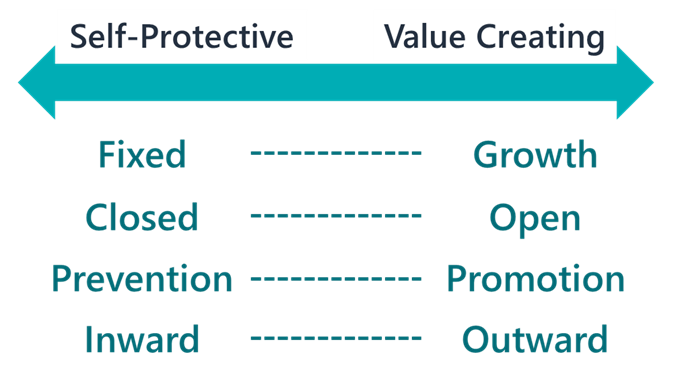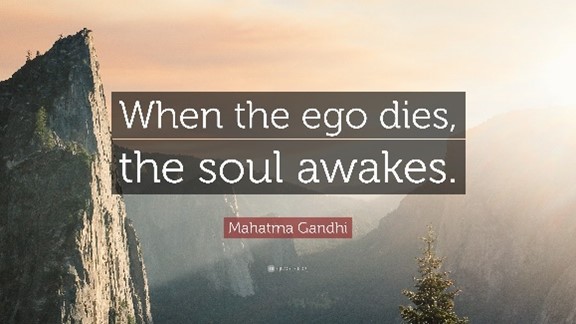I have been fortunate to work with thousands of people to upgrade their mindsets. Of those that exert effort to improve their mindsets (which is unfortunately a minority of people), I have observed three common mistakes in their mindset development practices and efforts.
In this article, I’ll identify what those mistakes are and how to counter them.
For context, here is the most comprehensive and research-backed mindset framework developed:

The quality of our mindsets falls somewhere along each of these continuums.
If you want to explore the quality of your mindsets so you know what mindset(s) you may need to work on, take this FREE Personal Mindset Assessment.
Mistake #1 – They Only Focus on Global Mindset Development Practices
Mindset development requires that we engage in small, frequent exercises to activate and strengthen our positive, value-creating mindsets.
There are two types of exercises that we can engage in: global and mindset-specific exercises.
Global exercises are exercises that are holistically good for the brain and help with all four sets of mindsets. There are two primary global exercises: meditation and gratitude journaling.
Mindset-specific exercises are exercises that specifically focus on the activation and strengthening of one of the four value-creating mindsets (Growth, Open, Promotion, or Outward). These exercises can include watching videos, reading articles, reading books, listening to podcasts, journaling, having discussions, and engaging in self-talk, all related to a specific mindset.
The most common mistake I see when I work with leaders and employees, is that they tend to prioritize and solely engage in the global exercises of meditation and gratitude journaling. While something is better than nothing, I believe the growth the occurs when engaging in global exercises is much slower than engaging in mindset-specific exercises.
How to counter this mistake: If you want to work on improving your mindsets, make sure you (1) identify a specific mindset you want to work on, and (2) engage in at least one mindset-specific exercise per day (or at least four days a week) for at least 30 days. You’ll be surprised how much you will change and grow over that time if you do this.
To create a Personal Mindset Development Plan and gain access to a wide variety of mindset-specific exercises, click here: Personal Mindset Development Plan.
Mistake #2 – They are Unwilling to Experiment
Mindset development also requires that we identify fear-connected programming within our internal operating system.
One of the best ways to identify this programming is to fill in the blank on these if then statements:
- Fixed Mindset: IF I fail, THEN _______________________ (what is something bad that we believe will happen? e.g., “I will be seen as a failure”)
- Closed Mindset: IF I admit that I am wrong, THEN _______________________ (what is something bad that we believe will happen? e.g., “I will lose the respect of others”)
- Prevention Mindset: IF I have problem under my watch, THEN _______________________ (what is something bad that we believe will happen? e.g., “I will have to play cleanup, which will be uncomfortable”)
- Inward Mindset: IF I don’t succeed or stand out, THEN _______________________ (what is something bad that we believe will happen? e.g., “I will lose ground that I have worked so hard to gain”)
Do any of these resonate with you more strongly than another?
Most of us can connect strongly to one of these, or something close to it. When we connect to our fear-connected programming, we need to experiment with our fears. For example:
- Could you fail at something (in an effort to push your boundaries), and see whether or not you are really seen as a failure?
- Could you admit that you’re wrong (in an effort to learn something new), and see whether or not you really lose the respect of others?
- Could you have a problem (in an effort to do something new and innovative), and see whether or not you really find the cleanup such a hassle?
- Could you put yourself on the backburner (in an effort to help others advance), and see whether or not you really lose ground?
For us to step more fully into Growth, Open, Promotion, or Outward mindsets, we need to be willing to push against our fears.
A common mistake I see when I work with leaders and employees, is that they are unwilling or lack the courage to engage in experiments to push against their fears.
How to counter this mistake: I think that it is extremely helpful for someone to have a coach in their mindset development journey. Among many reasons, a coach can help us make sure we set up the experiment appropriately, engage in the experiment, and process that experiment in a healthy way.
Mistake #3 – They Don’t Do Deeper Healing Work
In my personal experience developing my mindsets, I have had to work on developing all four of the value-creating mindsets. For me, I feel I was able to develop three of the four value-creating mindsets (Growth, Open, and Promotion) using mindset-specific practices. But, for me, the Inward mindset was sticky.
I have come to learn that one reason why it has been sticky is because of past trauma from my childhood.
While I made incremental improvement in developing an Outward mindset through mindset-specific exercises, I wasn’t able to make transformational improvement until I engaged in trauma therapy (e.g., EMDR and Internal Family Systems therapy).
A couple of common mistakes I see when I work with leaders and employees, is that they (1) don’t make the connection between their past trauma and their current mindsets, and (2) don’t engage with a therapist who can engage in neural-refining and upgrading treatments.
How to counter this mistake: I have two recommendations. First, I recommend that your read some books on trauma. Here are a couple that I highly recommend:
- What Happened to You?: Conversations on Trauma, Resilience, and Healing by Oprah Winfrey & Bruce Perry
- The Body Keeps the Score: Brain, Mind, and Body in the Healing of Trauma by Bessel van der Kolk
Second, I recommend that you engage with a trauma therapist. Learn what they do and how they might be able to help you heal your mind, body, and heart.
Want to Help Others Develop Value-Creating Mindsets?
If you want to help leaders or employees in your organization (1) awaken to the quality of their mindsets, and (2) develop more value-creating mindsets, let’s connect. I can promise you this: If you can elevate the mindsets of your leaders and employees, you will elevate your organization.
For more on this, check out this short video: Investigating the Sophistication of Your Executive Team











One Response
Great insights. Practical advice. Thanks!